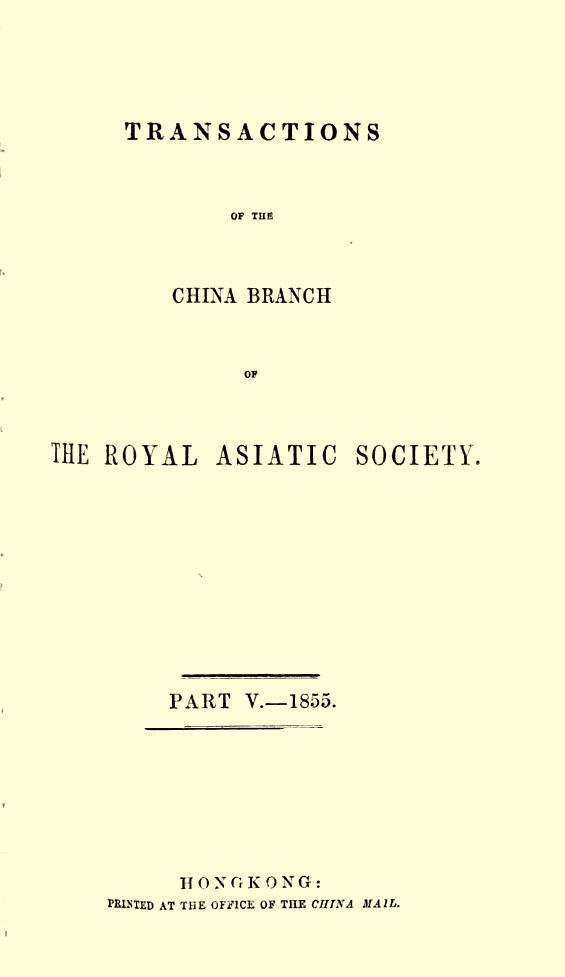|
  |
|
ARTICLE VIII.
PHYSICAL PHENOMENA IN JAPAN AND CHINA. NOTE ON RECENT PHYSICAL PHENOMENA IN JAPAN AND CHINA: By D. J. MacGowan, m.d. — Read before the Society, May 8th, 1855. |
. . . .
A marked change was observed in the bottom of the harbour, by the Powhatan, about three weeks after the earthquake. When the purt of Simoda was visited by the American squadron a year before, the adhesive mud in the bay afforded firm anchorage; but on revisiting the place, the bottom was discovered to be destitute of all mud, and so rocky, that the anchors, which found a resting-place with difficulty, were drawn up brightened by abrasion to which they had been subjected. The sediment had either been swept out to sea by retiring waves, or, what is more likely, it descended through the sub-aqueous fissures, causing the ebullition and whirlpool mentioned in the Diana's log. Frequent shocks were felt in the months of January and February last; none of any peculiar violence had occurred for seventy years previous to the late catastrophe.* In some of its features [the Japanese earthquake of December 23, 1855], the phenomenon just described bears a close resemblance to the earthquake of Lisbon in 1775. When the Lusitanian capital was destroyed, the inland waters of Scotland were agitated in a remarkable manner; and, at the same time, Madeira and other remote maritime regions were visited by waves of prodigious elevation. In like manner, after the earthquake at Simoda, the * A record of the earthquakes of Luzon, kept at Manila, and extending through a period of two hundred and fifty years, exhibits violent convulsions as occurring generally at interrals of about a quarter of a century, although they have been experienced at intervals of eighteen and thirty years. The slighter shocks, such as those of September last (referred ta in a previous note), and more recently in the month of March, occur without the semblance of regularity, and with extreme frequency. It has been observed, that the almost ever-active volcanoes of Albay and Taal become quiescent just before a violent earthquake, and that the island is entirely exempt from disturbance when they belch forth with greatest intensity. During the calamitous earthquake, however, of 16th September, 1852, (felt also in the China Sea), these volcanoes were subjected to entirely different influences. Taal — which had been inactive for some time — began shortly after the earthquake to vomit thick smoke, sand, and water. At Albay, on the contrary, the Volcano bad ceased to emit for some days before the earthquake; yet the shocks in the regions adjacent were less violent than at Manila. |
waters of a portion of the Chih-kiang province rose and fell, and at the Bonin Islands, the sea suddenly submerged the level portions of the land. It is calculated that the convulsion of 1775 extended over a portion of the earth's surface four times greater than the extent of Europe. The area of the earthquake just described, so far as can be ascertained, was comparatively of limited extent, and the action was far from being simultaneous. On the morning of the 24th of December, a "terrific tidal wave or bore" submerged the level portion of Port Lloyd, Peel Island — one of the Bonin group. The hour of its occurrence is not given by my correspondent, who writes, "we had to run for the hills, where we remained the whole day; in the evening, the tides being more regular, we re-embarked our men." The rise of the wave was twenty to twenty-five feet above high-water mark; it immediately receded, leaving the reefs entirely bare, and Ten Fathom Hole, in which the vessel was anchored, was turned into a complete whirlpool. The sea continued to rise and fall during the day, at intervals of fifteen minutes, gradually lessening its force until evening, when it nearly subsided to its usual level. At 7 P.M. of the 25th, the sea again retired, leaving the bottom of the bay dry, and returning to about fifteen feet above its normal limit, and so continued during the night. On the following morning the tides became regular. The force of the reflux was so great, that the What Cheer was dragged from her anchorage, and carried out of Ten Fathom Hole at the rate of eight miles an hour, barely escaping destruction. The houses of the residents were more or less swept away with some loss of life. Simoda is in 34° 39' 49" N., 138° 57' 50" E., about five hundred miles N.N.W. of Port Lloyd. Assuming that the first rise of the ocean took place at this port at 8 A.M., or 22 hours later than the same phenomenon at Simoda, the movement in this direction did not exceed forty-three miles an hour. Port Lloyd presents the appearance of being the crater of an extinct volcano. Some accounts of the Bonin Islands erroneously represent them as the seat of active volcanic agency: "Ten Fathom Hole" is doubtless a fissure of the crater. At about 5 P.M., December 24th, there was a remarkable rise of the waters in the departments of Hangchau (30° 20' 20" N., 120° 0734" E.), Kiahing (30° 52' 48" N., 120° 30' 11" E.), and Huchau (30° 52' 48° N., 119° 52' 54" E.) — that is to say, throughout that portion of the Imperial Canal and its feeders which lies in the Chihkiang province. . . . .
|
|
Source.
D. J. MacGowan, M.D.
This transcription was made from a volume at Google Books.
Last updated by Tom Tyler, Denver, CO, USA, Nov 3 2022.
|
|